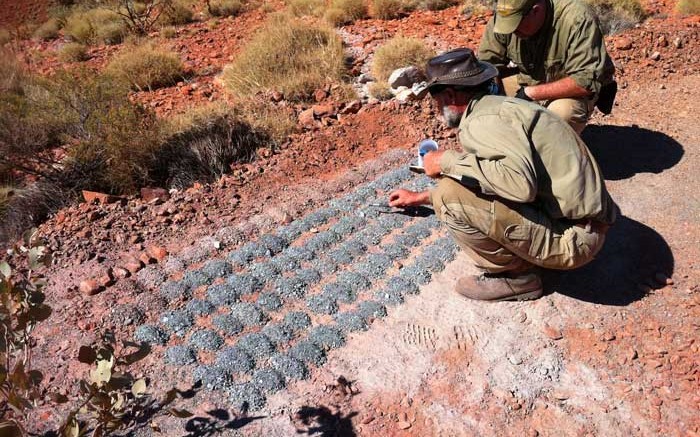Newmont Mining (TSX: NMC; NYSE: NEM) has acquired a 35.7% stake in Novo Resources (CNSX: NVO), a Vancouver-based junior that is earning a 70% interest in two exploration properties in the Eastern Pilbara shire of Western Australia that president and chief executive Quinton Hennigh believes could contain heaps of gold.
The Beatons Creek tenements cover much of the Beatons Creek conglomerates, a series of Archean-age pyritic groupings with gold mineralization that Hennigh describes as being similar to that of the Witwatersrand basin in South Africa.
“The underlying thesis or hypothesis that we are working on is that the Pilbara used to be connected to a block of rock known as the Kaapvaal craton in South Africa — they’re two pieces of the same puzzle,” Hennigh says. “If this is the case and we have the good fortune of finding that these deposits are continuous, this could be a significant gold discovery. We’re looking for something big.”
Novo’s tenements for the Beatons Creek gold project have three mining leases in which it is earning a 70% interest from Millennium Minerals (ASX: MOY); 560 sq. km. of prospecting and exploration tenements in which Novo is earning a 70% stake from the private Creasy Group, founded by Australian multi-millionaire prospector Mark Creasy; and three prospecting tenements in which Novo owns a 100% stake. (Millennium operates the Golden Eagle mine and mill, 8 km from Beatons Creek.)
Creasy, a British-born engineer who has lived in Australia for decades, and whose fortune was estimated at US$745 million by the U.K.’s Sunday Times’ “Rich List” in April — failed to conclude a deal with Newmont when the miner was interested in the prospector’s claims at Beatons Creek in 2005, Hennigh says, noting that he was working for Newmont at the time. Hennigh didn’t say why the deal failed, but Newmont’s loss was Hennigh’s gain, when Creasy agreed to a deal on the prospector’s ground in July 2012.
“We’re the first ones to get a really good kick at this can,” he says.
Hennigh notes that the area saw a bit of exploration in the late 1970s and early 1980s, but since then Creasy has held a lot of the ground. And the companies that poked around based on the Pilbara-Kaapvaal craton hypothesis were all looking in the wrong places.
“There were a few companies that came out there, but they came at it in their own different ways,” he says. “Why they were unsuccessful I don’t know, but almost none of them looked at the immediate prize — where the gold was actually outcropping — and work from there. What they did was go way out and put a hole in the ground in the middle of nowhere, on the blind hope that they would hit something. It was crazy.”
So far less than 1 sq. km of the 1,800 sq. km Beaton Creek project has been explored, and the project already has a National Instrument 43-101-compliant inferred resource of 8.9 million tonnes grading 1.47 grams gold per tonne for 421,000 contained oz. gold.
In July Novo started a reverse-circulation drill program on its wholly controlled ground at Beatons Creek and on the joint-venture property it holds with the Creasy Group. Hennigh noted at the time that recent surface sampling of gold-bearing conglomerates had returned encouraging results, including 55 outcrop chip samples grading more than 10 grams gold per tonne. “These conglomerate horizons dip gently, about three degrees south,” he noted in a press release at the time, “so we are confident they will be intersected at shallow depths over the entire target area.”
And because the average drill-hole depth ranges from 35 to 40 metres, the 49-hole — or 2,000-metre — drill program would cost $220,000. Novo says the shallow, gold-bearing conglomerates should underlie 4 sq. km at Beatons Creek. The company has 250 more drill holes permitted within the 4 sq. km area, if it continues drilling.
Omar Jabara, Newmont’s group executive for corporate communications, told The Northern Miner in an email that the company’s exploration strategy for many years has included investing in junior exploration companies.
“Novo has some attractive, prospective gold targets at its properties in the Pilbara Region of northwest Western Australia, and our investment is consistent with our long-standing approach vis-à-vis early stage targets with junior explorers,” he wrote. “Newmont looks forward to building on this relationship with Novo Resources.”
Newmont acquired its 17.8 million shares in private agreements with two Novo shareholders for 90¢ to 91.4¢ in cash per share, or $16 million. At press time, Novo shares were trading at 83¢, where they were just before the Newmont announcement that caused shares to shoot up briefly above $1.
A number of Novo’s warrants have been exercised, adding a healthy $4.8 million to Novo’s treasury in September.
Novo had 58 million shares outstanding after the latest exercise of warrants — or 64.4 million fully diluted — and at press time its market capitalization was $48 million.


Be the first to comment on "Newmont takes large stake in Hennigh’s Novo Resources"